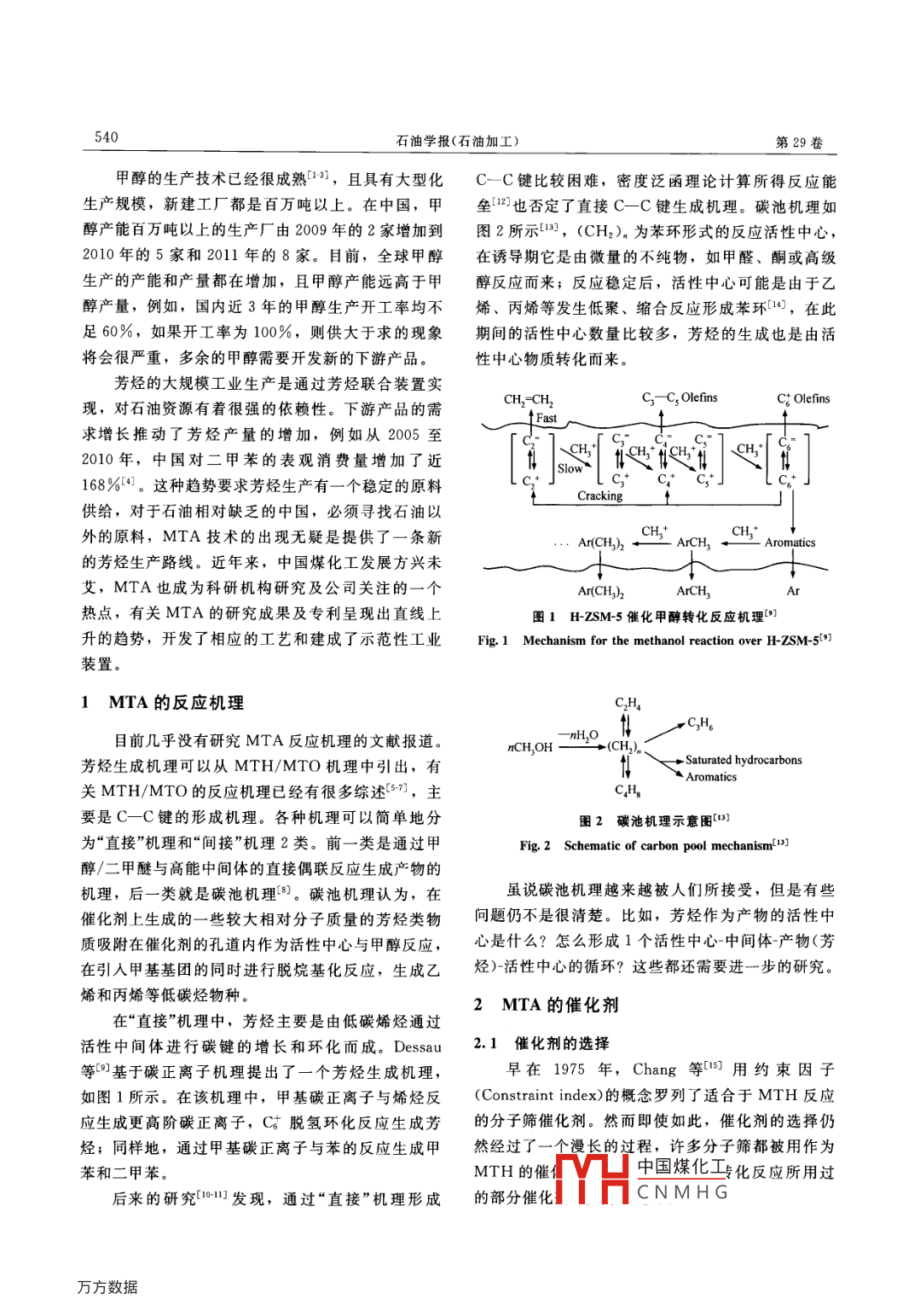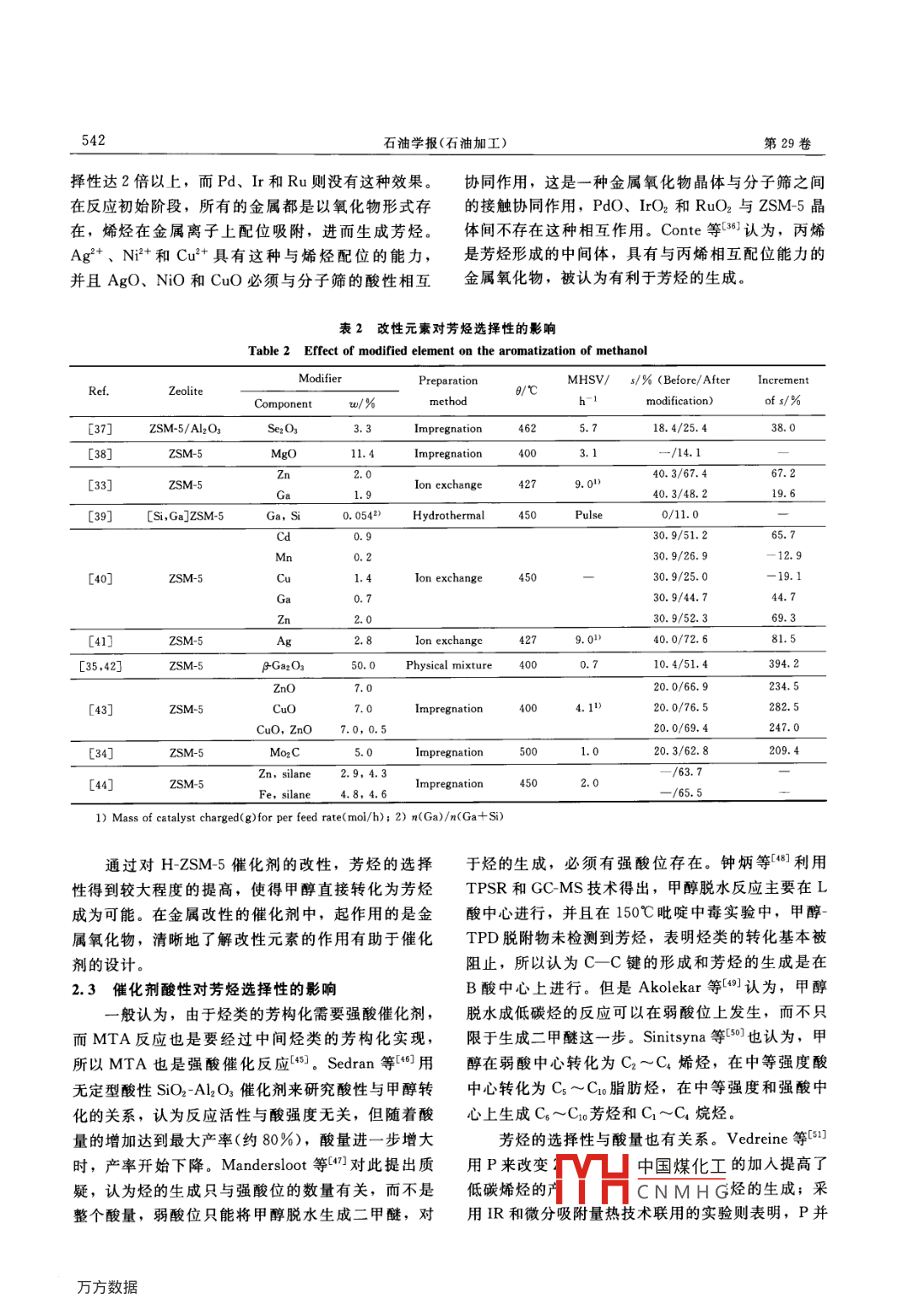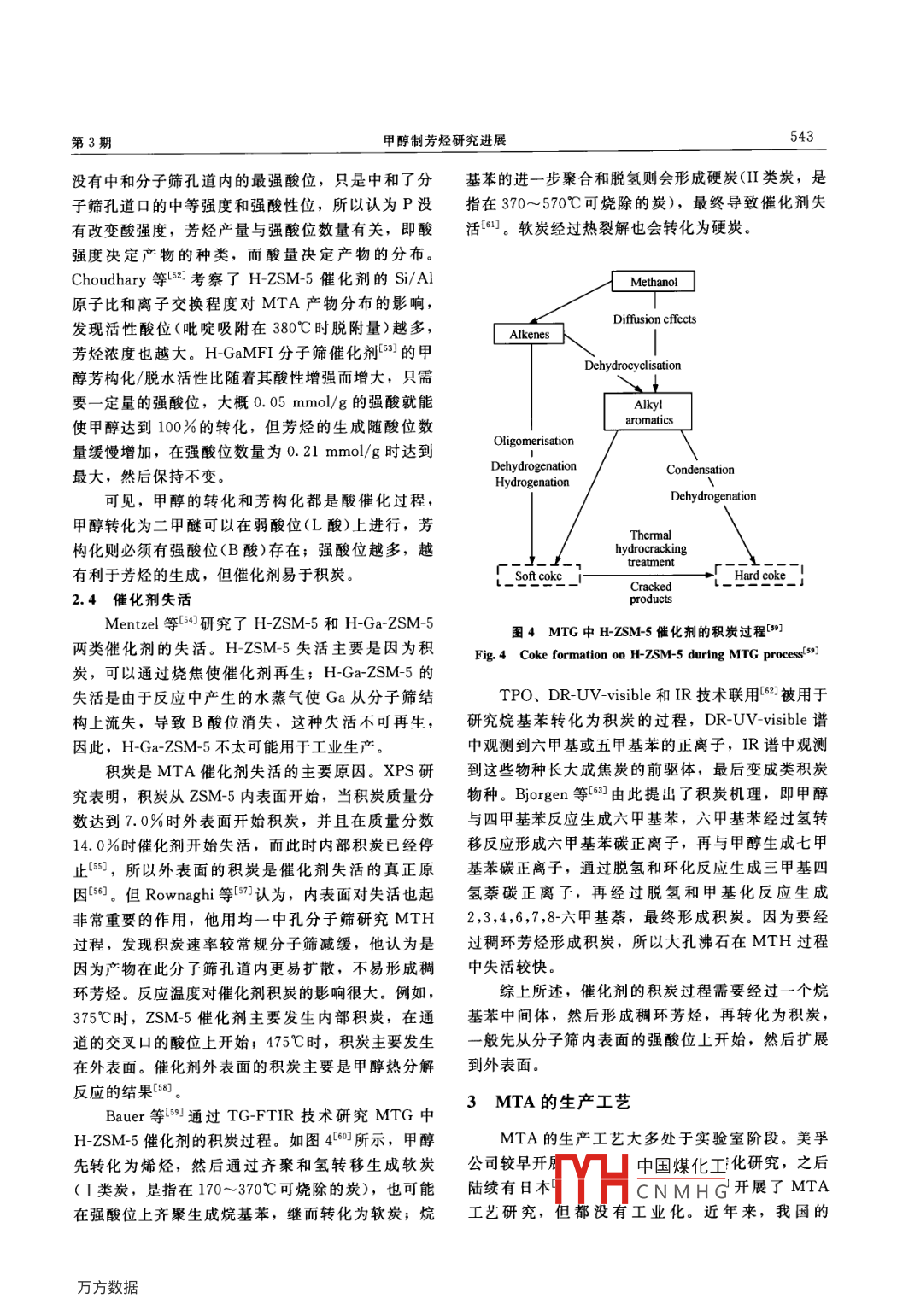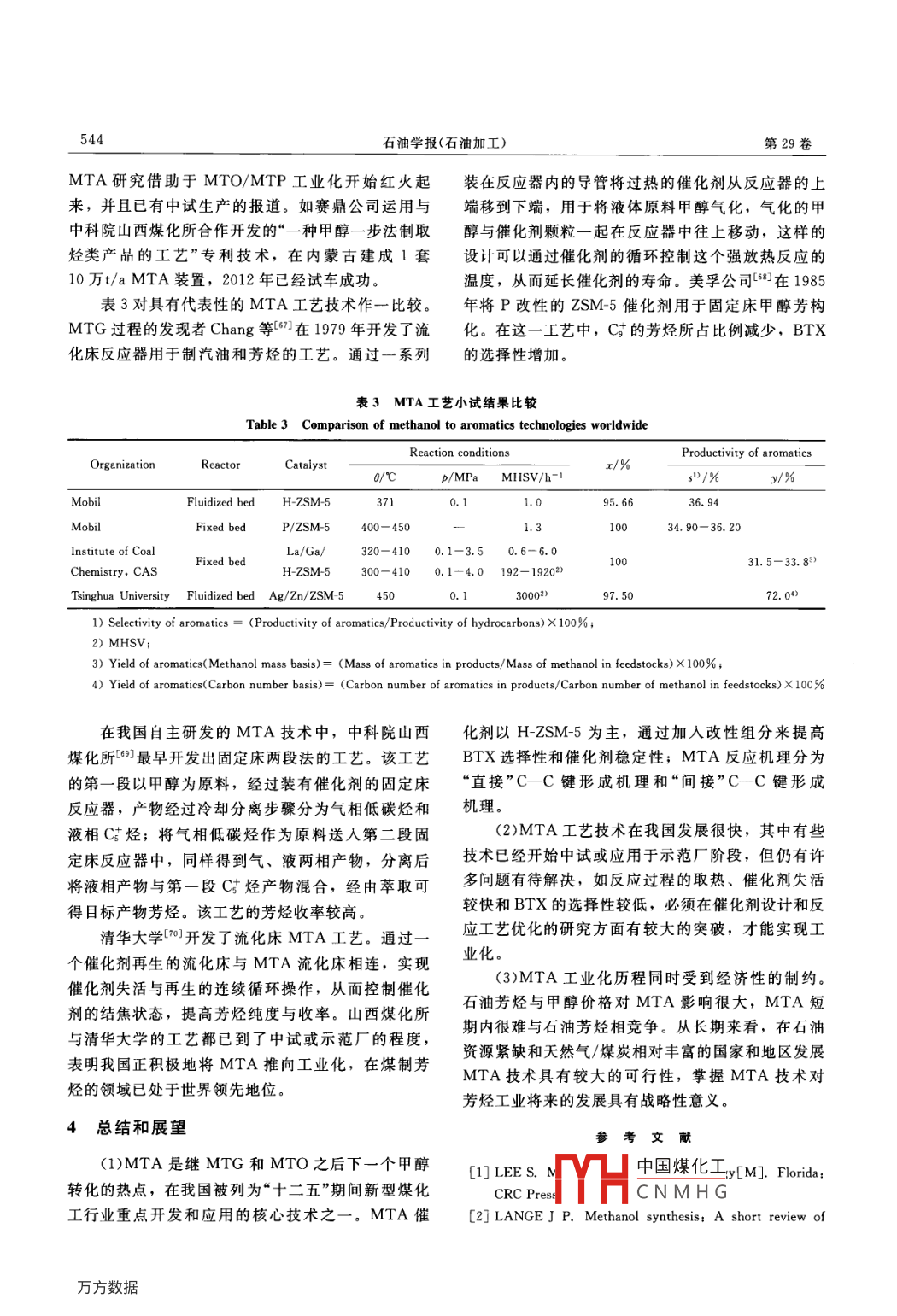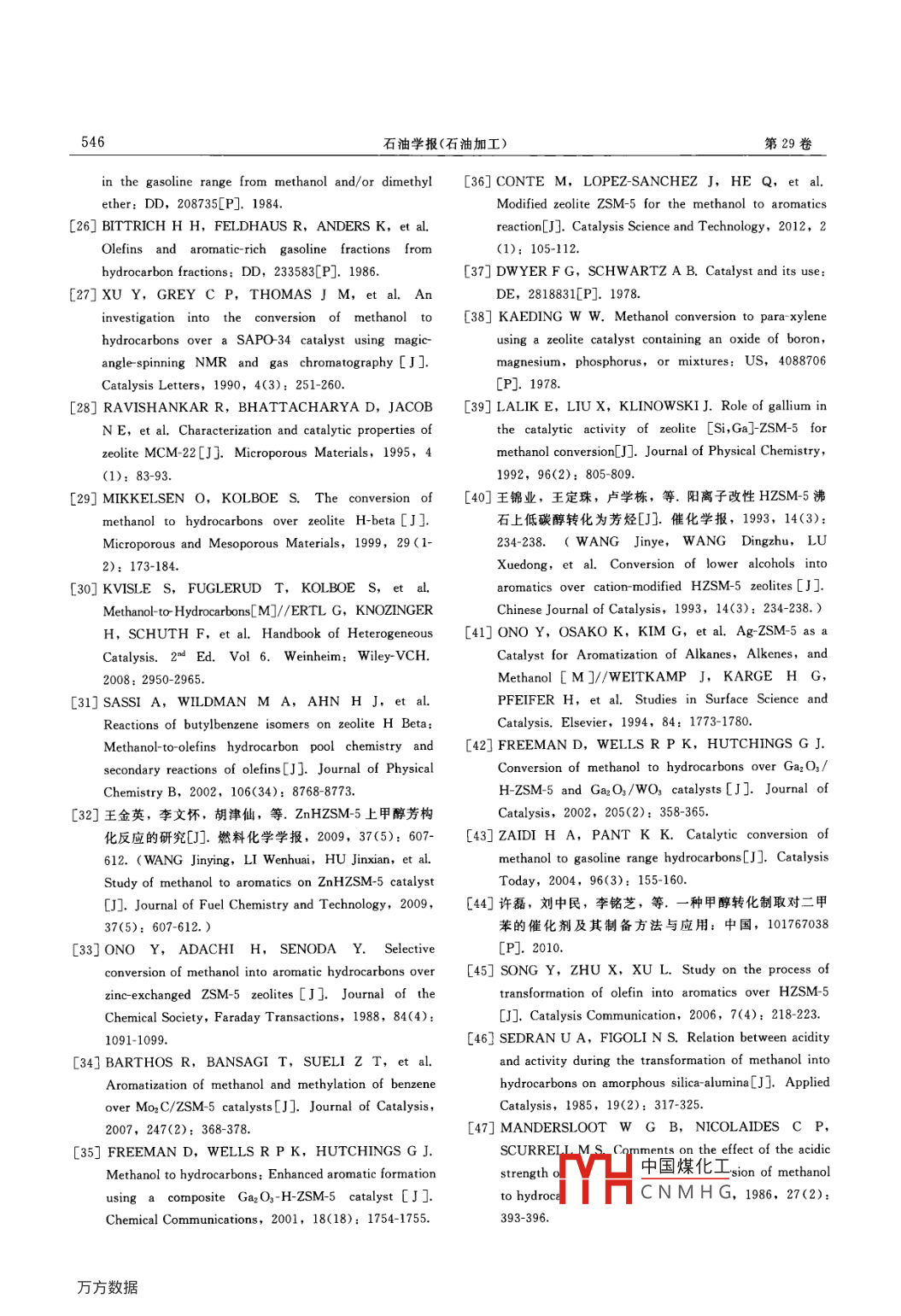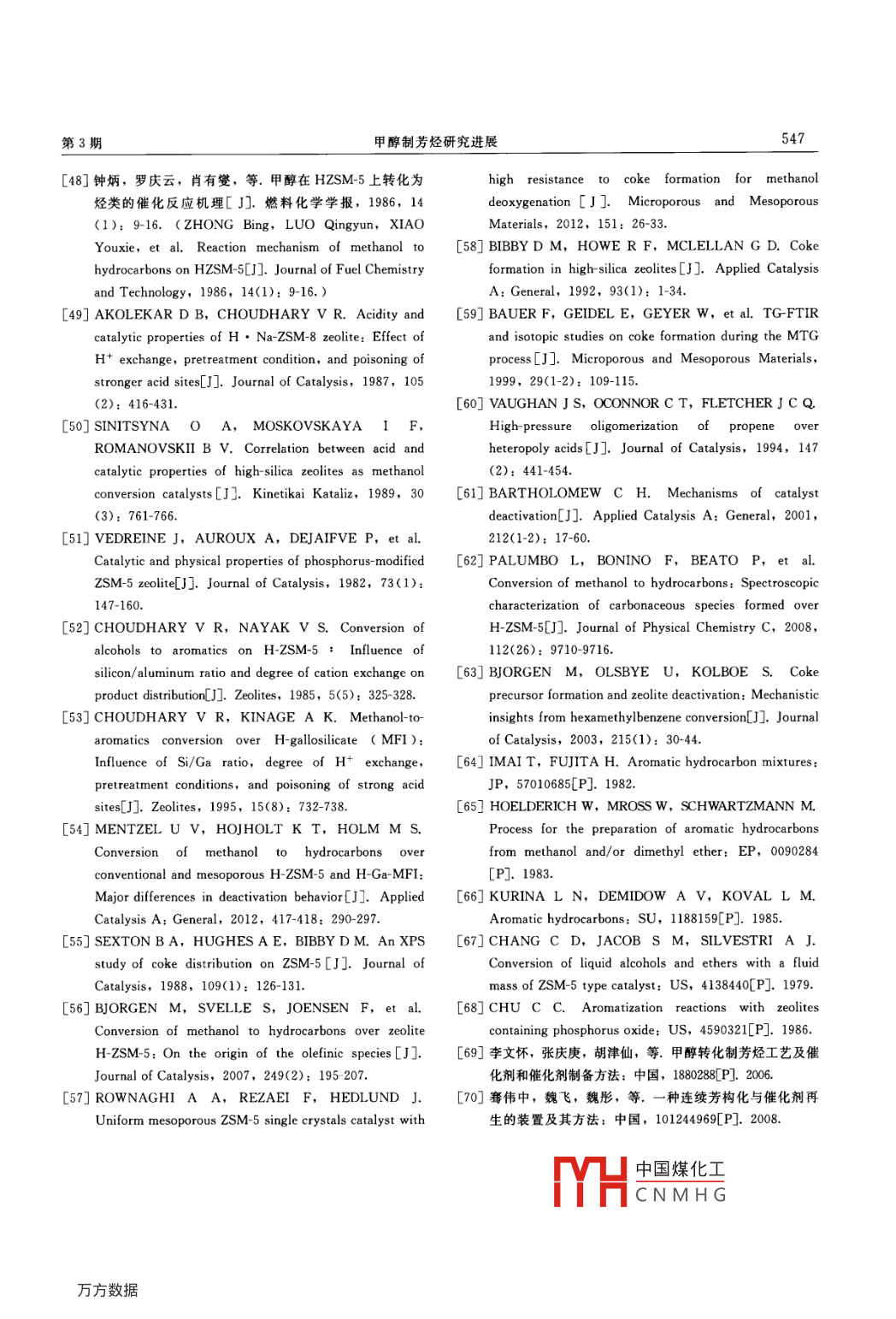

甲醇制芳烃研究进展免费下载-米乐app官方
- 期刊名字:石油学报(石油加工)
- 文件大小:306kb
- 论文作者:邹琥,吴巍,葸雷,朱宁,史军军
- 作者单位:中国石化石油化工科学研究院
- 更新时间:2020-06-12
- 下载次数:次
石油学报(石油加工2013年6月acta petrolei sinica(petroleum processing section)第29卷第3期文章编号:1001-8719(2013)03-0539-09甲醇制芳烃研究进展邹琥,吴巍,葸雷,朱宁,史军军(中国石化石油化工科学研究院,北京100083)摘要:甲醇制芳烃(mta)技术是从甲醇制烃(mth)技术发展而来。根据甲醇制烯烃(mto)的机理研究,mta的反应机理大致可以分为直接c—c键形成机理和间接c—c键形成机理(碳池机理)。mta是一个酸催化反应,主要以分子筛,尤其是以hzsm5分子筛为催化剂,再通过其他元素对分子筛进行改性以提高芳烃的选择性。反应中生成的稠环芳烃会转化为积炭,这是催化剂失活的主要原因。大多数mta技术仍然处于实验室研究阶段,在中国,中国科学院山西煤炭化学研究所和清华大学开发的mta技术已应用于中试装置或示范性工业装置关键词:甲醇;芳烃;甲醇制芳烃(mta);分子筛催化剂;工艺技术中图分类号:te646文献标识码:adoi:10.3969/j.isn.1001-8719.2013.03.028review of methanol to aromaticszou hu, wu wei, xi lei, zhu ning, shi junjunresearch institute of petroleum processing, sinopec, beijing 100083, china)abstract: methanol to aromatics(mta)process is evolved from the technology of methanol tohydrocarbons (mth). the reaction mechanism of mta, based on the methanol to olefins (mto)reaction mechanism, was roughly classified to direct c-c bond formation mechanism and indirectond formation mechanism(carbon pool mechanism). mtadwhich the molecular sieve, like h-zsm-5, is used as the catalyst. modifiers would be added to thecatalysts to improve the selectivity of aromatics. the condensed aromatics formed during mta canbe converted to coke, which is the reason of catalyst deactivation. most of the mta technologiesare still in the research stage. in china, the mta technologies separately developed by institute ofcoal chemistry of chinese academy of sciences and tsinghua university have been applied in pilotsor demonstration plants.key words: methanol; aromatics; methanol to aromatics ( mta); molecular sieve catalysts;process technology甲醇制芳烃( methanol to aromatics,mta)是昂,煤炭的运输(火车)费用也要占到其总价的3成指以甲醇为原料直接制备以苯、甲苯和二甲苯为主左右,所以很多甲醇生产厂都建在煤矿附近。例如的芳烃,是甲醇制烃( methanol to hydrocarbons,2010年国内甲醇产能占前5位的内蒙古、河南、山th)中的一部分。mta生产链主要由甲醇原料东、陕西和山西都是煤炭资源较丰富的省,甲醇生(天然气和煤)、mta原料(甲醇)和产物(芳烃)3部产占总产能的64%。即使从天然气和煤的经济性分分组成。就甲醇原料,即天然气和煤而言,天然气析,将它们转化为甲醇也是一个降低运输成本的有田一般位于较为偏远的地区,天然气的运输费用高效方法中国煤化工收稿日期:201209-14cnmhg通讯联系人:邹琥,男,博士,从事增产芳烃新技术研究;tel:010-82368815;e-mai540石油学报(石油加工)第29卷甲醇的生产技术已经很成熟13,且具有大型化c-c键比较困难,密度泛函理论计算所得反应能生产规模,新建工厂都是百万吨以上。在中国,甲垒2也否定了直接c—c键生成机理。碳池机理如醇产能百万吨以上的生产厂由2009年的2家增加到图2所示[13,(ch2)为苯环形式的反应活性中心,2010年的5家和2011年的8家。目前,全球甲醇在诱导期它是由微量的不纯物,如甲醛、酮或高级生产的产能和产量都在增加,且甲醇产能远高于甲醇反应而来;反应稳定后,活性中心可能是由于乙醇产量,例如,国内近3年的甲醇生产开工率均不烯、丙烯等发生低聚、缩合反应形成苯环14,在此足60%,如果开工率为100%,则供大于求的现象期间的活性中心数量比较多,芳烃的生成也是由活将会很严重,多余的甲醇需要开发新的下游产品。性中心物质转化而来。芳烃的大规模工业生产是通过芳烃联合装置实ch -cic.-c. olefins现,对石油资源有着很强的依赖性。下游产品的需fast求增长推动了芳烃产量的增加,例如从2005至2010年,中国对二甲苯的表观消费量增加了近se/=水168%。这种趋势要求芳烃生产有一个稳定的原料racking供给,对于石油相对缺乏的中国,必须寻找石油以外的原料,mta技术的出现无疑是提供了一条新arch3)2→arch,aromatics的芳烃生产路线。近年来,中国煤化工发展方兴未艾,mta也成为科研机构研究及公司关注的一个ar(ch,h2热点,有关mta的研究成果及专利呈现出直线上图1hzsm5催化甲醇转化反应机理升的趋势,开发了相应的工艺和建成了示范性工业fi1 mechanism for the methanol reaction over h-zsms装置1mta的反应机理c2h4ch6目前几乎没有研究mta反应机理的文献报道。nh2onch. oh(ch,芳烃生成机理可以从mth/mto机理中引出,有saturated hydrocarbonsaromatics关mth/mto的反应机理已经有很多综述7,主ch要是c—c键的形成机理。各种机理可以简单地分图2碳池机理示意图3为“直接”机理和“间接”机理2类。前一类是通过甲fig2 schematic of carbon pool mechanism[ 13醇/二甲醚与高能中间体的直接偶联反应生成产物的机理,后一类就是碳池机理。碳池机理认为,在虽说碳池机理越来越被人们所接受,但是有些催化剂上生成的一些较大相对分子质量的芳烃类物问题仍不是很清楚。比如,芳烃作为产物的活性中质吸附在催化剂的孔道内作为活性中心与甲醇反应,心是什么?怎么形成1个活性中心中间体产物(芳在引入甲基基团的同时进行脱烷基化反应,生成乙烃)活性中心的循环?这些都还需要进一步的研究。烯和丙烯等低碳烃物种。2mta的催化剂在“直接”机理中,芳烃主要是由低碳烯烃通过活性中间体进行碳键的增长和环化而成。 dessau2.1催化剂的选择等∞基于碳正离子机理提出了一个芳烃生成机理早在1975年, chang等(用约束因子如图1所示。在该机理中,甲基碳正离子与烯烃反 constraint index)的概念罗列了适合于mth反应应生成更高阶碳正离子,c脱氢环化反应生成芳的分子筛催化剂。然而即使如此,催化剂的选择仍烃;同样地,通过甲基碳正离子与苯的反应生成甲然经过了一个漫长的过程,许多分子筛都被用作为苯和二甲苯mth的催中国煤化乓化反应所用过后来的研究101发现,通过“直接”机理形成的部分催化cnmhg第3期甲醇制芳烃研究进展541表1甲醇转化催化剂及其芳烃选择性table 1 various catalysts used for methanol conversion and the aromatics selectivity (s)catalystfeedstocke/℃mhsv/h-1x/%s1)/%h-zsm-5meoh/dme382alzo3-h-zsm-531697.20[17] al2 o3 or al2 o3sio2/microporous glass400-4500.30100[18]hm(mordenitemeoh/water3312.[19]modified zeolitemeoh340-41097.00kz-izbh(borosilicate zeolite)meoh/ dme1.70[22]heteropoly acidmeoh13.10-71.6022.80-6.203)[23]erionite- offretite[24]hm/hy14.50/5.10[25] al modified sioz-b2 o3-nago glassa zeolite-alz o3meoh/ hydrocar650meoh/watermcm-2292.72meoh40010035.001)s=y(aromatics)/y( hydrocarbons)x100%; 2) reaction activity after 3 h; 3)selectivity of c6择形性是分子筛催化剂的关键,产物分布强烈对于孔径为0.55nm的zsm-5,它允许通过的分子地依赖于分子筛的孔结构。如果分子筛孔口太小,的上限为四甲基苯( durene),所以产物中有许多芳以至于苯环无法通过,那么芳烃就不能从分子筛笼烃产物;h-beta分子筛的十二元环开放孔道允许诸中逃逸出来,意昧着产物中只有c1~c5的烷烃和如六甲基苯的烷基苯自由地出入,只用于研究烯烃;另一方面,如果分子筛的孔径大到能让动力mth机理31。学直径大于0.7nm的分子通过,那么在产物中就尝试了多种分子筛催化剂,zsm5分子筛最终会存在许多诸如五甲基苯( pentamb)和六甲基苯成为mta最主要的催化剂( hexamb)的大分子芳烃。 kvisle等30给出了几种2.2催化剂改性组分对芳烃选择性的影响分子筛的拓扑结构来分析产物的可能性,如图3所通过分子筛改性可以增加mth反应中芳烃的示。sapo分子筛的孔口比较小,只有小于己烯的选择性,表2列出了含有不同改性组分催化剂催化线性分子能够通过,所以此分子筛用于烯烃的生产;甲醇转化反应的芳烃选择性。改性组分以ib、ib族金属元素为主,ga也是常用的改性组分之一。改sapo-34(cha)sapo-17(erd)性组分在其中所起的作用可以归纳为:(1)提供1个sapo-18(ael)zsm-5(mfd)beta(bea)l酸中心32或类似于mm oz的活性中心3,烯c烃的生成与此l酸中心脱氢活性有关,环烷烃中间体也可在l酸中心上脱氢生成芳烃,整个芳构化过」口■■程是l酸中心和b酸中心的协同催化作用;(2)提供了1个烯烃的脱氢中心,中间产物进而在zsm5810my包张■的酸性位上芳构化,如mc"和bg■■■过渡金属是一类主要的改性元素。 conte等30图3分子筛孔笼结构与mth产物关系示意图采用浸渍法考fb3 schematic illustration of the channel-cage relations mta活性,h中国煤化工5催化剂的cnmh gcu、ni、pd、in relevant topologiesir和ru。ag、cu和ni可以提高c6~c1芳烃的选542石油学报(石油加工)第29卷择性达2倍以上,而pd、ir和ru则没有这种效果。协同作用,这是一种金属氧化物晶体与分子筛之间在反应初始阶段,所有的金属都是以氧化物形式存的接触协同作用,pdo、iro2和ruo2与zsm5晶在,烯烃在金属离子上配位吸附,进而生成芳烃。体间不存在这种相互作用。 conte等认为,丙烯ag2 、ni2 和cu2 具有这种与烯烃配位的能力,是芳烃形成的中间体,具有与丙烯相互配位能力的并且ago、no和cuo必须与分子筛的酸性相互金属氧化物,被认为有利于芳烃的生成。表2改性元素对芳烃选择性的影响table 2 effect of modified element on the aromatization of methanolmodifierrationzeoliteb/c mhsv/ s/%(before/after incrementmodification)of s/7]zsm-5/al2 o33.3impregnation4625.718.4/25.438.0[38]zsm-5mgo11.4pregnat4003.1/14.140.3/67.4[3]zsm-5ion exchange42740.3/48.219.6[39] [si, gajzsm-5ga, si0. 0542) hydrothermal450pulse0/11.0.9/51.230.9/26.912.9zsm-5lon exchange19.130.9/444.730.9/52.3[41]zsm-5lon exchange9.0140.0/72.635,42]zsm-5a-ga: o350.0 physical mixture 4000.710.4/51.4394.2[43]zsm-5impregnation400cuo,zn07.0,0.5[34]zsm-5mo2 cimpregnation1.020.3/62.8209.4ne2.9,4.3/63.7[44zsm-5mpregnation1)mass of catalyst charged(g)for per feed rate(mol/h); 2)n(ga)/n(ga si)通过对hzsm5催化剂的改性,芳烃的选择于烃的生成,必须有强酸位存在。钟炳等]利用性得到较大程度的提高,使得甲醇直接转化为芳烃tpsr和gcms技术得出,甲醇脱水反应主要在l成为可能。在金属改性的催化剂中,起作用的是金酸中心进行,并且在150℃吡啶中毒实验中,甲醇属氧化物,清晰地了解改性元素的作用有助于催化tpd脱附物未检测到芳烃,表明烃类的转化基本被剂的设计阻止,所以认为c—c键的形成和芳烃的生成是在2.3催化剂酸性对芳烃选择性的影响b酸中心上进行。但是 akolekar等4认为,甲醇一般认为,由于烃类的芳构化需要强酸催化剂,脱水成低碳烃的反应可以在弱酸位上发生,而不只而mta反应也是要经过中间烃类的芳构化实现,限于生成二甲醚这一步。 sinitsyna等0也认为,甲所以mta也是强酸催化反应。 sedran等41用醇在弱酸中心转化为c2~c4烯烃,在中等强度酸无定型酸性so2-al2o3催化剂来研究酸性与甲醇转中心转化为cs~c10脂肪烃,在中等强度和强酸中化的关系,认为反应活性与酸强度无关,但随着酸心上生成c6~c芳烃和c1~c烷烃。量的增加达到最大产率(约80%),酸量进一步增大芳烃的选择性与酸量也有关系。 vedreine等时,产率开始下降。 mandersloot-等t对此提出质用p来改变v凵中国煤化工的加入提高了疑,认为烃的生成只与强酸位的数量有关,而不是低碳烯烃的cnmhg烃的生成;采整个酸量,弱酸位只能将甲醇脱水生成二甲醚,对用ir和微分吸附量热技术联用的实验则表明,p并第3期甲醇制芳烃研究进543没有中和分子筛孔道内的最强酸位,只是中和了分基苯的进一步聚合和脱氢则会形成硬炭(i类炭,是子筛孔道口的中等强度和强酸性位,所以认为p没指在370~570℃可烧除的炭),最终导致催化剂失有改变酸强度,芳烃产量与强酸位数量有关,即酸活。软炭经过热裂解也会转化为硬炭强度决定产物的种类,而酸量决定产物的分布。choudhary等2)考察了hzsm5催化剂的si/al原子比和离子交换程度对mta产物分布的影响发现活性酸位(吡啶吸附在380℃时脱附量)越多,diffusion effectsalkenes芳烃浓度也越大。 h-gamfi分子筛催化剂3的甲dehydrocyclisation醇芳构化/脱水活性比随着其酸性增强而增大,只需要一定量的强酸位,大概0.05mmol/g的强酸就能使甲醇达到100%的转化,但芳烃的生成随酸位数量缓慢增加,在强酸位数量为0.21mmol/g时达到oligomerisation最大,然后保持不变dehydrogenation可见,甲醇的转化和芳构化都是酸催化过程甲醇转化为二甲醚可以在弱酸位(l酸)上进行,芳thermal构化则必须有强酸位(b酸)存在;强酸位越多,越hydrocrackingtreatment有利于芳烃的生成,但催化剂易于积炭hard cokeracked2.4催化剂失活productsmentzel等54研究了hzsm5和 h-ga-zsm5图4mig中hzsm5催化剂的积炭过程两类催化剂的失活。hzsm-5失活主要是因为积fig. 4 coke formation on h-zsm-5 during mtg process[ 93炭,可以通过烧焦使催化剂再生;hga-zsm5的失活是由于反应中产生的水蒸气使ga从分子筛结tpo、druv- visible和ir技术联用62被用于构上流失,导致b酸位消失,这种失活不可再生,研究烷基苯转化为积炭的过程,dr- uv-visible谱因此, h-ga-zsm5不太可能用于工业生产。中观测到六甲基或五甲基苯的正离子,ir谱中观测积炭是mta催化剂失活的主要原因。xps研到这些物种长大成焦炭的前驱体,最后变成类积炭究表明,积炭从zsm5内表面开始,当积炭质量分物种。 bjorgen等3由此提出了积炭机理,即甲醇数达到7.0%时外表面开始积炭,并且在质量分数与四甲基苯反应生成六甲基苯,六甲基苯经过氢转140%时催化剂开始失活,而此时内部积炭已经停移反应形成六甲基苯碳正离子,再与甲醇生成七甲止s5,所以外表面的积炭是催化剂失活的真正原基苯碳正离子,通过脱氢和环化反应生成三甲基四因)。但 rownaghi等认为,内表面对失活也起氢萘碳正离子,再经过脱氢和甲基化反应生成非常重要的作用,他用均一中孔分子筛研究mth2,3,4,6,7,8-六甲基萘,最终形成积炭。因为要经过程,发现积炭速率较常规分子筛减缓,他认为是过稠环芳烃形成积炭,所以大孔沸石在mth过程因为产物在此分子筛孔道内更易扩散,不易形成稠中失活较快。环芳烃。反应温度对催化剂积炭的影响很大。例如,综上所述,催化剂的积炭过程需要经过一个烷375℃时,zsm5催化剂主要发生内部积炭,在通基苯中间体,然后形成稠环芳烃,再转化为积炭,道的交叉口的酸位上开始;475℃时,积炭主要发生一般先从分子筛内表面的强酸位上开始,然后扩展在外表面。催化剂外表面的积炭主要是甲醇热分解到外表面。反应的结果。bauer等通过 tg-ftir技术研究mtg中3mta的生产工艺hzsm5催化剂的积炭过程。如图460所示,甲醇mta的生产工艺大多处于实验室阶段。美孚先转化为烯烃,然后通过齐聚和氢转移生成软炭公司较早开v凵中国煤化工化研究,之后i类炭,是指在170~370℃可烧除的炭),也可能陆续有日本cnmhg开展了mta在强酸位上齐聚生成烷基苯,继而转化为软炭;烷工艺研究,但都没有工业化。近年来,我国的544石油学报(石油加工)第29卷mta研究借助于 mto/mtp工业化开始红火起装在反应器内的导管将过热的催化剂从反应器的上来,并且已有中试生产的报道。如赛鼎公司运用与端移到下端,用于将液体原料甲醇气化,气化的甲中科院山西煤化所合作开发的“一种甲醇一步法制取醇与催化剂颗粒一起在反应器中往上移动,这样的烃类产品的工艺”专利技术,在内蒙古建成1套设计可以通过催化剂的循环控制这个强放热反应的10万t/amta装置,2012年已经试车成功。温度,从而延长催化剂的寿命。美孚公司8在1985表3对具有代表性的mta工艺技术作一比较。年将p改性的zsm5催化剂用于固定床甲醇芳构atg过程的发现者 chang等在1979年开发了流化。在这一工艺中,c的芳烃所占比例减少,btx化床反应器用于制汽油和芳烃的工艺。通过一系列的选择性增加。表3mta工艺小试结果比较table 3 comparison of methanol to aromatics technologies worldwidereaction conditionsproductivity of aromaticsorganizationreactorcatalystx/%6/℃p/mpa mhsv/h-is)/%mobil fluidized bed h-zsm-5 371 0.1fixed bed p/zsm-5 400-45034,90-36.20institute of coalfixed bed0.1-3.50.6-6.031.5-33.83)chemistry, cash-zsm-50.1-4.0192-19202tsinghua university fluidized bed ag/zn/zsm-5 4503000297.5072.04)1)selectivity of aromatics =( productivity of aromatics/productivity of hydrocarbons)x100%:2)mhsv3)yield of aromatics( methanol mass basis)=(mass of aromatics in products/mass of methanol in feedstocks)x100%4)yield of aromatics( carbon number basis)=( carbon number of aromatics in products/ carbon number of methanol in feedstocks)x100%在我国自主研发的mta技术中,中科院山西化剂以hzsm5为主,通过加入改性组分来提高煤化所最早开发出固定床两段法的工艺。该工艺btx选择性和催化剂稳定性;mta反应机理分为的第一段以甲醇为原料,经过装有催化剂的固定床“直接”c-c键形成机理和“间接”c—c键形成反应器,产物经过冷却分离步骤分为气相低碳烃和机理液相¢烃;将气相低碳烃作为原料送入第二段固(2)mta工艺技术在我国发展很快,其中有些定床反应器中,同样得到气、液两相产物,分离后技术已经开始中试或应用于示范厂阶段,但仍有许将液相产物与第一段c烃产物混合,经由萃取可多问题有待解决,如反应过程的取热、催化剂失活得目标产物芳烃。该工艺的芳烃收率较高。较快和btx的选择性较低,必须在催化剂设计和反清华大学0开发了流化床mta工艺。通过应工艺优化的研究方面有较大的突破,才能实现工个催化剂再生的流化床与mta流化床相连,实现业化催化剂失活与再生的连续循环操作,从而控制催化(3)mta工业化历程同时受到经济性的制约。剂的结焦状态,提高芳烃纯度与收率。山西煤化所石油芳烃与甲醇价格对mta影响很大,mta短与清华大学的工艺都已到了中试或示范厂的程度,期内很难与石油芳烃相竞争。从长期来看,在石油表明我国正积极地将mta推向工业化,在煤制芳资源紧缺和天然气/煤炭相对丰富的国家和地区发展烃的领域已处于世界领先地位mta技术具有较大的可行性,掌握mta技术对芳烃工业将来的发展具有战略性意义。4总结和展望(1)mta是继mtg和mto之后下一个甲醇[1] lee s中国煤化工ym.ford转化的热点,在我国被列为“十二五”期间新型煤化dhcnmhg工行业重点开发和应用的核心技术之一。mta催[2] lange j f. methanol synthesis: a short review第3期甲醇制芳烃研究进展545technology improvements [j]. catalysis today, 2001, [13] dahl i m, kolboe s. on the reaction mechanism64(1-2):3-8.for hydrocarbon formation from methanol over sapo-34[3]周士义,李杰.甲醇合成技术进展[].化工科技2 isotopic labeling studies of the co-reaction of propene2011, 19(5):73-76. (zhou shiyi, li jie. progressand methanol]. journal of catalysis, 1996, 161(1)on synthesis technology of methanol [j]. sciencetechnology in chemical industry, 2011, 19(5):73- [14] song w, marcus d m, fu h, et al. anoft-studied reaction that may never have been: direct[4]黄祥俊.对二甲苯市场综述及营销策略[].中国石油catalytic conversion of methanol or dimethyl ether to和化工标准与质量,2011,12(12):211-212.( huanghydrocarbons on the solid acids hzsm-5 or hsapo-34xiangjun. marketing strategy of p-xylene [j].china[j]. journal of the american chemical society, 2002petroleum and chemical standard and quality, 2011124(15):3844-384512(12):211-212.)[15 chang c d, silvestri a, smith r l[5] stocker m. methanol-to-hydrocarbons: catalyticproduction of gasoline hydrocarbons us, 3928483materials and their behavior [j]. microporous and[p].1975mesoporous materials, 1999, 29(1-2):3-48.[16] gb 1446522-1976. production of aromatic compounds[6] haw j f, song w g, marcus d m, et al. themechanism of methanol to hydrocarbon catalysis [j]. [17] robinson j g, bames d i, carswell a maccounts of chemical research, 2003, 36(5):317-326improvements in catalysis: ep, 0039996[p].1981[7]邢爱华,林泉,朱伟平,等.甲醇制烯烃反应机理研究[18] seddon d, mole t, whiteside j a. methanol进展[j].天然气化工,2011,36(1):59-65.(xingversion to hydrocarbons with zeolites and cocatalystsaihua, lin quan, zhu weiping, et al. advance inwo,8201866[p].1982esearch on reaction mechanism for methanol to olefins [19] mihail r, straja s, maria g, et al. a kineti[]. natural gas chemical industry,2011,36(1):59-model for methanol conversion to hydrocarbons [j].65.)chemical engineering science(9):1581-1591[8] dahl i m, kolboe s. on the reaction mechanism [20] parker l m, bibby d m. synthesis and somefor propene formation in the mto reaction over sapo-34properties of two novel zeolites, kz-1 and kz-2[j][j]. catalysis letters, 1993, 20(3-4):329-336zeolites,1983,3(1):8-11.[9] dessau r m, lapierre r b. on the mechanism of [21] hoelderich w, mross w, schwartzmann mmethanol conversion to hydrocarbons over hzsm-5[j]process for the preparation of aromatic hydrocarbojournal of catalysis, 1982,78(1):136-14from methanol and/or dimethyl ether: ep, 0090284[10]王仰东,王传明,刘红星,等. hsapo34分子筛上氧[p].1983鑰叶立德机理的第一性原理研究[].催化学报,2010,[22]蔡天锡,周永生,王大庆,等.杂多酸催化剂上甲醇转31(1): 33-37.( wang yangdong, wang chuanming化为烃的研究[j].催化学报,1984,5(2):180-184.liu hongxing, et al. a first-principle study of(cai tianxi, zhou yongsheng, wang daqing, et al.oxonium ylide mechanism over hsapo-34 zeolite [j]chinese journal of catalysis, 2010, 31(1): 33-37.heteropoly compounds as catalysts[j]. chinese journal[11] hunter r, hutchings g j, pickl wof catalysis,1984,5(2):180-184.)mechanistic studies on initial c-c bond formation in the [23] ceckiewicz s. conversion of methanol into lightzeolite zsm-5 catalysed methanol conversion reaction:hydrocarbons on erionite-offretite zeolite[j]. journal ofevidence against a radical pathway [j]. journal of thethe chemical society, faraday transactions 1, 1984chemical society, chemical communications, 1987,1184(11):2989-2998(11):843-844.24itoh h, hidalgoc v, hattori t, et al. role[12] lesthaeghe d, vans v, marin g, et alof acid property of various zeolites in the methanolunderstanding the failure of direct c-c coupling in theconversionbons[i l. journal of catalysiszeolite-catalzed methanoi-to-olefin process [j 1.中国煤化工angewandte chemie international edition, 2006, 45 [25] janowcnmhgrt d, et al(11):1714-1719.catalyst and method for producing hydrocarbons boiling546石油学报(石油加工)第29卷in the gasoline range from methanol and/or dimethyl [36] conte m, lopez-sanchez j, heether:dd,208735[p].1984.modified zeolite zsm-5 for the methanol[26] bittrich hh, feldhaus r, anders k, et al.reaction[j]. catalysis science and technology, 2012, 2olefins and aromatic-rich gasoline fractions from(1):105-112.hydrocarbon fractions: dd, 233583[p].1986[37] dwyer f g, schwartz a b. catalyst and its use[27] xu y, grey c p, thomas j m, et al. ande,2818831p].1978investigation into the conversion of methanol to [38] kaeding ww. methanol conversion to para- xylenehydrocarbons over a sapo-34 catalyst using magic-using a zeolite catalyst containing an oxide of boronangle-spinning nmr and gas chromatography [j]magnesium, phosphorus, or mixtures: us, 4088706catalysis letters, 1990, 4(3): 251-260.p].1978.[28] ravishankar r, bhattacharya d, jacob [39] lalik e, liu x, klinowski j. role of gallium inne, et al. characterizationthe catalytic activity of zeolite [si, gaj-zsm-5 forzeolite mcm-22[j]. micropmaterials, 1995,4methanol conversion[j. journal of physical chemistry(1):83-93.1992,96(2):805-809[29] mikkelsen o, kolboe s. the conversion of[40]王锦业,王定珠,卢学栋,等.阳离子改性hzm5沸methanol to hydrocarbons over zeolite h-beta [j]石上低碳醇转化为芳烃[j].催化学报,1993,14(3):microporous and mesoporous materials, 1999, 29(1234-238. wang jinye, wang dingzhu, lu):173-184xuedong, et al. conversion of lower alcohols into[30] kvisle s, fuglerud t, kolboe s, et al.aromatics over cation-modified hzsm-5 zeolites [j]methanol-to- hydrocarbons[ mj//ertl g, knozingerchinese journal of catalysis, 1993, 14(3): 234-238.)h, schuth f, et al. handbook of heterogeneous [41] ono y, osako k, kim g, et al. ag-zsm-5 as acatalysis. 2nd ed. vol 6. weinheim: wiley-vch.catalyst for aromatization of alkanes, alkenes, and2008:2950-2965methanol m //weitkamp j, karge h g[31] sassi a, wildmanpfeifer h, et al. studies in surface science andreactions of butylbenzene isomers on zeolite h beta:1994,84:1773-1methanol-to-olefins hydrocarbon pool chemistry and [42] freeman d, wells r p k, hutchingsg jsecondary reactions of olefins [j]. journal of physicalconversion of methanol to hydrocarbons over ga2 o3/chemistry b,2002,106(34):8768-8773.h-zsm-5 and ga2 o3/wo3 catalysts [j]. journal of[32]王金英,李文怀,胡津仙,等, znhzsm5上甲醇芳构catalysis,2002,205(2):358-365.化反应的研究[j.燃料化学学报,209,37(5):607-[43] zaidi h a, pant kk. catalytic conversion of612.( wang jinying, li wenhuai, hu jinxian, et al.methanol to gasoline range hydrocarbons [j]. catalysisstudy of methanol to aromatics on znhzsm-5 catalysttoday,2004,96(3):155-160[j]. journal of fuel chemistry and technology,2009,[44许磊,刘中民,李铭芝,等.一种甲醇转化制取对二甲37(5):607-612.)苯的催化剂及其制备方法与应用:中国,101767038[33] ono y, adachi h, senodaselectiveconversion of methanol into aromatic hydrocarbons over [45] song y, zhu x, xu l. study on the process ofzinc-exchanged zsm-5 zeolites [j]. journal of thetransformation of olefin into aromatics over hzsmchemical society, faraday transactions, 1988, 84(4):[j]. catalysis communication, 2006, 7(4): 218-223.1091-1099.[46] sedran u a, figoli n s. relation between acidity[34] barthos r, bansagi t, sueli z t, et al.and activity during the transformation of methanol intoaromatization of methanol and methylation of benzenehydrocarbons on amorphous silica-alumina[j]. appliedover moz c/zsm-5 catalysts[j]. journal of catalysiscatalysis,1985,19(2):317-3252007,247(2):368-378[47]mandersloot w g b, nicolaides c p,[35] freeman d, wells r p k, hutchings g j.scurretents on the effect of the acidicmethanol to hydrocarbons: enhanced aromatic formation中国煤化工ion of methanolusing a composite ga2 o3-h-zsm-5cnmhg,1986,27(2)chemical communications, 2001, 18(18):1754-1755.393-396第3期甲醇制芳烃研究进展547[48]钟炳,罗庆云,肖有燮,等.甲醇在hzsm5上转化为high resistance to coke formation for methanol烃类的催化反应机理[j].燃料化学学报,1986,14microporous and mesoporous(1):9-16.( zhong bing, luo qingyun, xiaomaterials,2012,151:26-33youxie, et al. reaction mechanism of methanol[58 bibby d m, howe r f, mclellan g d. cokehydrocarbons on hzsm-5[j]. journal of fuel chemistryformation in high-silica zeolites [j]. applied catalysisand technology, 1986, 14(1):9-16)a: general,1992,93(1):1-34[49] akolekar d b, choudhary vr. acidity and [59] bauer f, geidel e, geyer w, et al. tg-ftircatalytic properties of h. na-zsm-8 zeolite: effect ofand isotopic studies on coke formation during the mtgh exchange, pretreatment condition, and poisoning ofprocess [j]. microporous and mesoporous materialsstronger acid sites[j]. journal of catalysis, 1987, 1051999,29(1-2):109-115.(2):416-431[60 vaughan j s, oconnor c t, fletcher j c q[50] sinitsyna o a, moskovskaya i fofopeneromanovskii b v. correlation between acid andheteropoly acids[j]. journal of catalysis, 1994, 147catalytic properties of high-silica zeolites as methanol(2):441-454.conversion catalysts [j]. kinetikai kataliz, 1989, 30 [61] bartholomew c h. mechanisms of catalyst(3):761-766deactivation[j]. applied catalysis a: general,2001[51] vedreine j, auroux a, dejaifve p, et al.212(1-2):17-60catalytic and physical properties of phosphorus-modified [62] palumbo l, bonino f, beato p, et al.zsm-5 zeolite[j. journal of catalysis, 1982, 73(1):conversion of methanol to hydrocarbons spectrosco147-160.characterization of carbonaformed[52] choudhary v r, nayak v s. conversion ofh-zsm-50j]. journal of physical chemistry calcohols to aromatics on h-zsm-5 influence of112(26):9710-9716silicon/aluminum ratio and degree of cation exchange on [63] bjorgen m, olsbye u, kolboe s. cokeproduct distribution[j]. zeolites, 1985, 5(5):325-328.precursor formation and zeolite deactivation: mechanistic[53 choudhary v r, kinage a k. methanol-to-insights from hexamethylbenzene conversion[j]. journalaromatics conversion over h-gallosilicate mfi ):of catalysis,2003,215(1):30-44influence of si/ga ratio, degree of h* exchange, [64 imai t, fujita h. aromatic hydrocarbon mixturespretreatment conditions, and poisoning of strong acidjp,57010685[p].1982sites[j. zeolites,1995,15(8):732-738[65 hoelderich w, mross w, schwartzmann m.[54] mentzel u v, hojholt k t, holm m sprocess for the preparation of aromatic hydrocarbonsconversion of methanol to hydrocarbons overfrom methanol and/or dimethyl ether: ep, 0090284conventional and mesoporous h-zsm-5 and h-ga-mfi:[p].1983major differences in deactivation behavior[j]. applied [66] kurina l n, demidow a v, koval l m.catalysis a: general, 2012, 417-418: 290-297aromatic hydrocarbons: su, 1188159[p]. 1985[55]sexton b a, hughes a e, bibby d m. an xps [67] chang c d, jacob s m, silvestri a jstudy of coke distribution on zsm-5 [j]. journal oconversion of liquid alcohols and ethers with a fluidcatalysis,1988,109(1):126-131mass of zsm-5 type catalyst us, 4138440[p]. 1979.[56] bjorgen m, svelle s, joensen f, et al. [68] chu c c. aromatization reactions with zeolitesconversion of methanol to hydrocarbons over zeolitecontaining phosphorus oxide: us, 4590321[p]. 1986h-zsm-5: on the origin of the olefinic species [j]69]李文怀,张庆庚,胡津仙,等.甲醇转化制芳烃工艺及催journal of catalysis, 2007, 249(2): 195-207.化剂和催化剂制备方法:中国,1880288p].2006.[57] rownaghi aa, rezaei f, hedlund j.[70]骞伟中,魏飞,魏彤,等.一种连续芳构化与催化剂再uniform mesoporous zsm-5 single crystals catalyst with生的装置及其方法:中国,101244969[p].2008中国煤化工cnmhg
-
c4烯烃制丙烯催化剂 2020-06-12
-
煤基聚乙醇酸技术进展 2020-06-12
-
生物质能的应用工程 2020-06-12
-
我国甲醇工业现状 2020-06-12
-
jb/t 11699-2013 高处作业吊篮安装、拆卸、使用技术规程 2020-06-12
-
石油化工设备腐蚀与防护参考书十本免费下载,绝版珍藏 2020-06-12
-
四喷嘴水煤浆气化炉工业应用情况简介 2020-06-12
-
lurgi和ici低压甲醇合成工艺比较 2020-06-12
-
甲醇制芳烃研究进展 2020-06-12
-
精甲醇及mto级甲醇精馏工艺技术进展 2020-06-12
